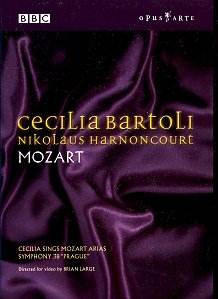I have had a problem with Bartoli in that I knew a
music brat in grammar school who vaguely resembled her, and this
has hindered my appreciation of her — until now. But here she
sings beautifully, face right in the camera, gorgeous hair and
skin, demonstrating her agile high coloratura and rich low range,
perhaps overdoing the dramatics just a little. The famous eyebrows
have been tamed, and she manages to smile all the time while she’s
singing except, of course, when the music requires a tragic visage.
And the audience goes crazy! This being unfamiliar music we are
probably not ever going to hear it any better than this.
It used to be required of an opera singer that
he or she raise welts in the far back row under the balcony where
the music critics sat in those gigantic concert halls. Naturally
such power required a large platform from which to launch it.
In the mid-20th century recordings brought to prominence another
kind of voice, one that was supple and dramatic, capable of not
just one or two good notes but of various whole good ranges of
expression. Such voices were often not large, and often disappointing
when heard live in large halls. Now, an additional requirement
has been added—not just how they sound and how they act, but how
do they look with the camera in their face? If Schwarzkopf was
one of the first to pass this test magnificently, Bartoli is every
bit as good. Some other singers—Ewing and Malifitano, for instance—don’t,
whatever their abilities otherwise.
Of the Symphony No. 38 this is a fully sculptured
performance attained after many rehearsals. Not a phrase goes
by that has not been carefully worked out. In keeping with recent
Mozart scholarship the high brass are more prominent that one
might be used to. My two favourite performances of this work have
been with Kubelik and the Chicago SO and the Leinsdorf with the
RPO, but this one easily ranks with them. They must have been
doing something right because the hair on my neck stood on end
throughout. I could have used a little more flute, however, à
la Kubelik. The orchestra plays as if it is the last thing they’ll
ever do, and by the end Harnoncourt looks like he’s just been
hauled out of the river. The audience at first seemed a little
overawed by all this passion, but they quickly warmed up and then
began shouting bravo!. All in all, a thoroughly memorable
bit of work.
The behind-the-scenes video shows some interesting
things. I didn’t realise that Bartoli was such an Anglophone.
Harnoncourt speaks to her in English, (switching instantly to
German for the orchestra, and then Italian when giving everybody
their cues in the Mozart text.) and she mouths "thank you"
to the Austrian audience, not grazie or danke. There
is an interesting demonstration of the three remote control cameras
located within the orchestra and controlled from the control room
by joystick.
A video of the Haydn Scena di Berenice
(due for release Summer 2003) was taped at the same time, and
we have a generous preview of that; there is an unfortunate BRRRRPT
on the sound track at the end of this. In the rehearsal clips
Harnoncourt and Bartoli converse in English. Harnoncourt is obviously
still getting used to his contact lenses and makes some odd faces
at times.
Paul Shoemaker

